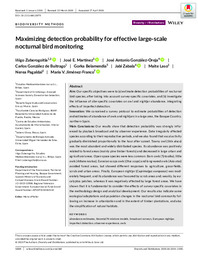Please use this identifier to cite or link to this item:
https://hdl.handle.net/11000/34894Full metadata record
| DC Field | Value | Language |
|---|---|---|
| dc.contributor.author | Zuberogoitia, Iñigo | - |
| dc.contributor.author | Martínez, José Enrique | - |
| dc.contributor.author | González-Oreja, José A. | - |
| dc.contributor.author | González de Buitrago, Carlos | - |
| dc.contributor.author | Belamendia, Gorka | - |
| dc.contributor.author | Zabala, Jabi | - |
| dc.contributor.author | Laso, Maite | - |
| dc.contributor.author | Pagaldai, Nerea | - |
| dc.contributor.author | Jiménez Franco, María Victoria | - |
| dc.contributor.other | Departamentos de la UMH::Biología Aplicada | es_ES |
| dc.date.accessioned | 2025-01-18T09:12:24Z | - |
| dc.date.available | 2025-01-18T09:12:24Z | - |
| dc.date.created | 2020-04-17 | - |
| dc.identifier.citation | Diversity and Distributions. Volume26, Issue8 August 2020 . Pages 1034-1050 | es_ES |
| dc.identifier.issn | 1366-9516 | - |
| dc.identifier.issn | 1472-4642 | - |
| dc.identifier.uri | https://hdl.handle.net/11000/34894 | - |
| dc.description.abstract | Aim: Our specific objectives were to (a) estimate detection probabilities of nocturnalbird species, after taking into account survey-specific covariates, and (b) investigatethe influence of site-specific covariates on owl and nightjar abundance, integratingeffects of imperfect detection.Innovation: We conceived a survey protocol to estimate probabilities of detectionand estimates of abundance of owls and nightjars in a large area, the Basque Country,northern Spain.Main Conclusions: Our results show that detection probability was strongly influ-enced by playback broadcast and by observer experience. Date irregularly affectedspecies according to their reproductive periods, and we also found that vocal activitygradually diminished proportionally to the hour after sunset. Tawny owl (Strix aluco)was the most abundant and widely distributed species. Its abundance was positivelyrelated to forest areas (mainly pine timber forests) and decreased in large urban andagricultural areas. Open space species were less common. Barn owls (Tyto alba), littleowls (Athene noctua), Eurasian scops owls (Otus scops) and long-eared owls (Asio otus)avoided forest areas, but showed different responses to agriculture, grass-fields,scrub and urban areas. Finally, European nightjar (Caprimulgus europaeus) was mod-erately frequent, and its abundance was favoured by scrub areas and, weakly, by eu-calyptus patches, whereas it was negatively affected by large forest areas. We haveshown that it is fundamental to consider the effects of survey-specific covariates inthe methodology design and analytical development. Our results also indicate someecological adaptations and population changes in the nocturnal bird community fol-lowing an increase in urbanization and in the extent of timber plantations, and alsothe simplification of natural habitats | es_ES |
| dc.format | application/pdf | es_ES |
| dc.format.extent | 17 | es_ES |
| dc.language.iso | eng | es_ES |
| dc.publisher | Wiley | es_ES |
| dc.rights | info:eu-repo/semantics/openAccess | es_ES |
| dc.rights | Attribution-NonCommercial-NoDerivatives 4.0 Internacional | * |
| dc.rights.uri | http://creativecommons.org/licenses/by-nc-nd/4.0/ | * |
| dc.subject | Abundance estimates | es_ES |
| dc.subject | Binomial N-mixture models | es_ES |
| dc.subject | Broadcast surveys | es_ES |
| dc.subject | European nightjar | es_ES |
| dc.subject | Imperfect detection | es_ES |
| dc.subject | Observer experience | es_ES |
| dc.subject | Owls | es_ES |
| dc.title | Maximizing detection probability for effective large-scale nocturnal bird monitoring | es_ES |
| dc.type | info:eu-repo/semantics/article | es_ES |
| dc.relation.publisherversion | https://doi.org/10.1111/ddi.13075 | es_ES |

View/Open:
Maximizing detection probability for effective large-scale noturnal bird monitoring.pdf
1,86 MB
Adobe PDF
Share:
.png)
